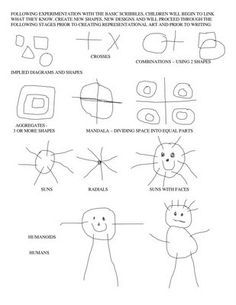The Fascinating Journey Through Your Child’s Drawing Development
Hello, Super Parents! Are you ready to dive into the whimsical world of your little ones and their magical marker masterpieces? I’ve got my crayons at the ready to guide you through the vibrant stages of drawing development in early childhood. Let’s make sense of those squiggles and foster our future Picassos!
Introduction to Drawing Stages
Drawing is more than just child’s play; it’s a window into your child’s ever-expanding mind. Watching your tot’s scribbles evolve into recognizable shapes and scenes is a rite of passage that is as thrilling for you as it is for them. Let’s set the paper on the easel and embark on this journey of discovery together!
Why Drawing Matters for Early Development
Drawing isn’t just fun for kids; it’s critical for their motor skills, problem-solving abilities, and emotional expression. It helps little ones hone fine motor skills as they learn to control their grip and movement. Plus, it’s an early form of communication before the whirlwind of words comes into play. Every stroke and doodle is part of their personal tale!
The Stages of Drawing in Early Childhood
- Stage 1: Random Scribbling (15 months to 2 ½ years) – Unleash the paper! During this initial stage, toddlers experience the joy of movement and cause-and-effect as they wiggle their crayons all over the place.
- Stage 2: Controlled Scribbling (2 to 3 years) – Here come the patterns! As their hand-eye coordination improves, so does their ability to make deliberate marks, different shapes, and even a controlled scribble or two.
- Stage 3: Drawing Shapes and Patterns (2 ½ to 3 ½ years) – Circle here, square there, and voila! We’ve got some basic shapes! Patterns and various shapes start to dominate the page, as they begin to understand and replicate forms.
- Stage 4: Design Stage (3 to 4 years) – Now, their shapes take form! Kids start combining different shapes to create more complex patterns and designs that might resemble real-life objects.
- Stage 5: Pictorial Stage (4 to 5 years) – A picture is worth a thousand words, and boy, do those pictures start coming! Recognizable objects and scenes begin to emerge, telling stories about their interests and experiences.
Supporting Your Child’s Drawing Development
It’s wonderful to witness your child’s drawing stages, but even better to actively support their creative growth. Here are some tips to get you both scribbling with joy!
- Provide a variety of art materials – from chunky chalks to fine-tipped markers, the options are endless.
- Create a dedicated art space – whether it’s a corner of the kitchen table or a portable art box, make sure they have a place to create.
- Show genuine interest – comment on the colors, strokes, and what you feel about their artwork.
- Let them experiment – there is no ‘right’ or ‘wrong’ way to draw, so let their imagination run wild!
- Introduce art appreciation early – talk about different types of art and artists, fostering an early love for the arts.
Remember, parents, the key to nurturing your child’s drawing ability is to encourage them without focusing on perfection. Celebrate their progress, not just the finished masterpiece. Every child’s drawing journey is unique, filled with vibrant twists and turns, so grab your box of crayons, and let’s color this adventure with joy and enthusiasm!
Stay tuned as we delve more deeply into each drawing stage with tips and activities to further encourage your child’s artistic growth. From navigating the scribbly seas to mastering mountaintops of masterpieces, we’ll explore how to ensure your child’s journey through the art world is as fulfilling as it can be.
In our next chapter, we’ll look at the first stage: random scribbling. Yes, it may look like chaos, but trust me, it’s the foundation of a would-be art connoisseur!

5 Things Parents Should Know in Preparing for Drawing Stages in Early Childhood
1. Embrace the Mess
Before we dive into our art supplies, let’s talk practicality. Early drawing often equals a bit of chaos. So, invest in some easy-clean floor mats, aprons, and washable art materials. Remember, sometimes the best creative processes are the messiest!
2. Set Realistic Expectations
It’s natural to dream about your child’s artwork gracing the fridge, but it’s key to set realistic expectations. Their initial scribbles won’t look like much, and that’s perfectly okay. Focus on the fun rather than the outcome.
3. Milestones Vary
Just like walking and talking, every child’s artistic timeline is different. While one 3-year-old might be etching out stick figures, another might still be enjoying the freedom of abstract squiggles. Both are mastering important skills!
4. Encourage, but Don’t Direct
It’s tempting to guide your kiddo’s hand or suggest what to draw. Resist the urge! Encouragement is fab, but the freedom to explore is what truly unlocks creativity. Ask them to tell you about their drawing instead of guessing what it is.
5. Integrate Drawing into Daily Routines
Consistency can do wonders. Make drawing a regular part of playtime. Just a few minutes a day can encourage them to express themselves and develop their fine motor skills. Plus, it’s a perfect bonding activity!
Expanding on the Drawing Stages
Now, shall we explore each stage a bit further? Let’s pack our virtual art bag full of tips for each enchanting phase. I can’t wait to share how you can tailor your support to match your child’s artistic journey!
Note that these stages are not strict age guidelines but general phases that kids tend to follow in their creative development. Your little artist might zip through some stages or linger in others.
Random Scribbling
In this spontaneous burst of energy, your child is simply exploring their sensory and motor skills. It can look chaotic, but it’s their way of connecting with the world. Keep your camera ready – these first marks are precious beginnings!
Controlled Scribbling
Now you’ll notice more purpose in their marks. To encourage this, create ‘scribble challenges’. Can they make a straight line? A wavy one? This gives them a goal but within a vast ocean of possibilities.
Drawing Shapes and Patterns
As they tackle shapes, puzzles and shape-sorters can be super helpful. They’re learning the fundamental building blocks of all drawing – and of course, their future signature!
Design Stage
Celebrate the designs that emerge. Maybe a shape looks like a house or a circle atop a rectangle becomes a person. Each combination is a step closer to representing their world.
Pictorial Stage
Resist the urge to correct anatomical inaccuracies in their art. A purple sky or a person with arms coming out of their head is part of the charm. Talk about what they’ve drawn to understand their perspective.
Finally, a little patience goes a long way. Whether they’re in the throes of scribbling fury or carefully drawing their family, watch with admiration. After all, every mark on that paper is a mark of growth. Let’s cherish each and every stroke!
See more great Things to Do with Kids in New Zealand here. For more information see here
Disclaimer
The articles available via our website provide general information only and we strongly urge readers to exercise caution and conduct their own thorough research and fact-checking. The information presented should not be taken as absolute truth, and, to the maximum extent permitted by law, we will not be held liable for any inaccuracies or errors in the content. It is essential for individuals to independently verify and validate the information before making any decisions or taking any actions based on the articles.




